




Jennifer Fink’s passion for service paves the way to prosperity
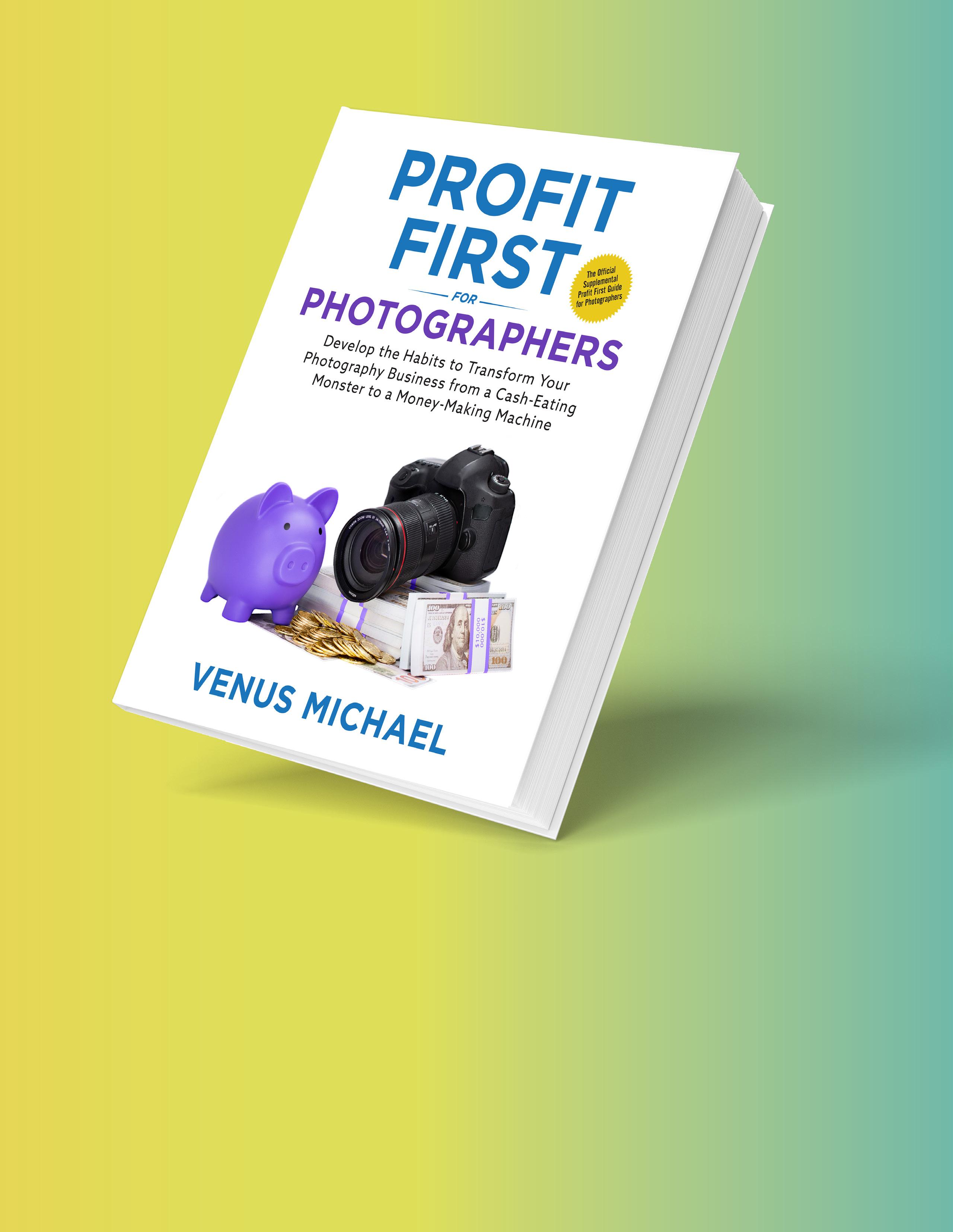
Picture This. Coming in 2024


From Passion to Prosperity: Jennifer Fink finds success through the power of service





Marketing Lesson
Marketing 101
Protecting Creators
The Power of copyright
Amanda Shuman
Carrying your brand to the next level with love.
Ask Venus
Answers to real bookkeeping questions from real clients.
20 Questions
Everything you wanted to know aboutProfit First but were too afraid to ask.
Growth, Change, Success Insights from a banker.
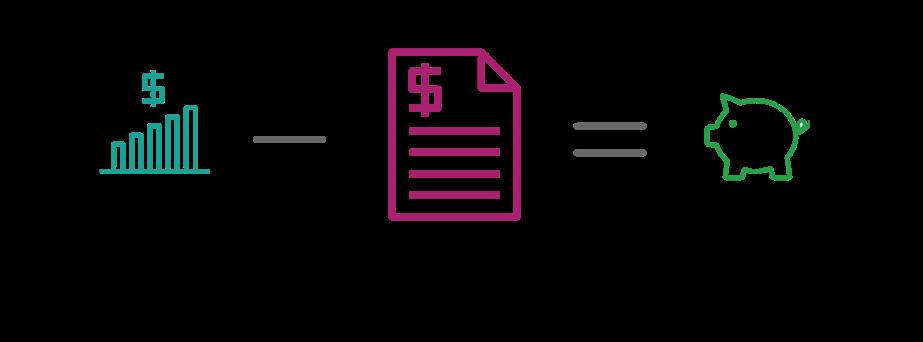
In this model, your business’s profits are whatever money will be left over. It’s simple in theory, but it is more likely to leave you with less profit—if you have any at all. Why? Because you’re human, and humans aren’t good at keeping leftovers. If you have food to eat, you eat it. If you have money to spend, you spend it.

What you need is a formula that prioritizes your profit, so that you know at the beginning of the year how much money you want left. By deciding up front how much you want to have at the end of the year, you force yourself to find ways to get the same things done for less money.


in our entrepreneurial journeys, we’re going to hit speed bumps. There will be setbacks. The product line doesn’t fly; employees quit; investors start pressing for outcomes. Even personal challenges may seep through the crevices, suffusing every moment with the weight of stress and anxiety. But it’s precisely in these turbulent moments that our resilience is tested and our true mettle shines through. Which is why positivity is such a key element in daily business. In fact, when entrepreneurs choose to be positive and surround themselves with the right types of voices, it greatly increases their odds of success.
So, my question to you is this: In the face of catastrophe, how do you stay positive? Here’s what a decade of entrepreneurship has taught me.
Truth #1: Individual events do not define your business. While a disgruntled client, a failed marketing campaign, or a personal setback may seem catastrophic in the moment, there is no single event that will make or break your business. If one client is disgruntled, you are not going under.
Before succumbing to disappointment, take stock of your business’ successes. Try to gain perspective. Once you’ve moved past the emotional “everything is falling apart” phase, then you can revisit your setbacks and learn from them.
Truth #2: Your self-worth is independent of business success or failure. Connecting your self-worth to financial success or job performance is perilous. Because there is always more you could be doing, it’s hard to feel like you are ever enough. There are so many factors outside of our control. If your worth is tied to your performance, you will take deep dips in every personal setback.
Truth #3: Every setback offers value. An unhappy client taught me how to be more clear in the sales process. A bad investment in a marketing strategy taught me how to create simple and effective marketing campaigns. A messy departure with a team member taught me to trust my instincts. Yes, my setbacks cost me money at first. But they’ve made me money in the long run.
To be candid, it’s an ongoing challenge. Setbacks happen, and it ruffles my feathers. But after I stomp and moan, I revisit these truths. While disappointments won’t break your business, handling them like a pro will be the measure of your success.
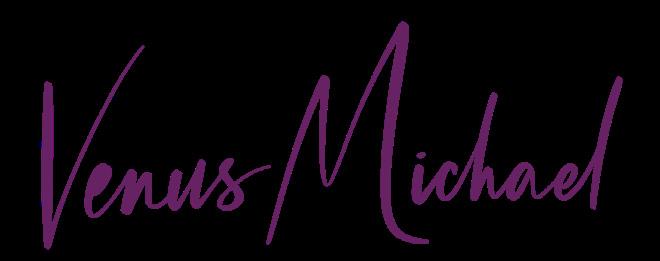

When entrepreneurs choose to be positive and surround themselves with the right types of voices, it greatly increases their odds of success.

Marketing 101: Listening to the consumer is always a winning strategy.

Anyone who’s been through TSA or has seen bags loaded or unloaded onto a plane from their window seat knows that traveling isn’t exactly gentle on luggage. Still, multiple people with roller bags and totes from the travel and accessories brand Béis recently took to social media to share visible wear and tear on their bags, sometimes saying it appeared after just one trip. Through social listening, the company’s staff noticed—and decided to host a retro, carwash-themed event called “Béis Wash” to clean people’s bags
and show them how to keep them looking fresh.
What happened? More than 1,200 people attended the event, and creator posts about Béis Wash across Instagram, TikTok, X, and YouTube had a combined reach of 7.2 million, according to stats provided by Béis. Additionally, Béis added supplementary how-tos and promo videos to support the initiative.
By addressing the issue firsthand, the brand was able to turn a potentially negative backlash into a positive by leveraging multi-channel marketing.
“We’re always going to be looking for what the consumer is asking us,” Liz Money, SVP of brand and creative at Béis told Marketing Brew. “And we’re always going to do our very best to answer that.” And by doing so, Béis created a unique high-traffic and high-revenue moment. So what’s the key takeaway for your business? Listening matters. Getting in front of your clients and consumers and providing them with services that go beyond selling them a product is always a winwin strategy.
51.9% of content creators in the industry are women, with men making up 48.1%.
200 MILLION Active content creators $104.2 BILLION The estimated worth of the creator economy 62% of content creators say that focusing on a particular niche helps them get more engagement and reach $75/h
The average income of content creators who run a business
MARKETING DIVE
Pomodoro Technique
• Set a timer for 25 minutes of work.
• Take a short 5-minute break.
• After 4 cycles, take a longer 15-30 minute break.
Eisenhower Matrix
• Sort tasks by urgency and importance.
• Do urgent and important tasks immediately. Schedule, delegate, or delete others accordingly.
ABCDE Method
• Label tasks A-E by importance.
• Focus on ‘A’ tasks first.
• Expect 80% of results from them.
80/20 Method
• Identify tasks with the most impact.
• Focus 20% of effort on these.
• Expect 80% of results from them.
3-3-3 Method
• Dedicate 3 hours to deep work.
• Complete 3 shorter tasks.
• Address 3 maintenance tasks.
2 Minute Rule
• If a task takes < 2 minutes, do it now.
• Larger tasks get scheduled or delegated.
• Keeps small tasks from piling up.
Eat the Frog
• Start your day with the most challenging task.
• Gain momentum and a sense of achievement early.
• Makes subsequent tasks feel easier in comparison.
Getting Things Done (GTD)
• Capture all tasks.
• Clarify and organize into lists.
• Reflect and engage with action.

Kanban Board
• Visualize tasks in ‘To Do,’ ‘Doing,’ ‘Done.’
• Move tasks along as progress is made.
• Optimizes flow and prioritization.
Task Batching
• Group similar tasks together.
• Work on these in dedicated time blocks.
• Increases focus and efficiency.
Warren Buffet 5/25 Rule
• List 25 important tasks.
• Pick the top 5 to focus on.
• Avoid the rest until top 5 are complete.
Time Blocking
• Dedicate blocks for specific tasks.
• Include breaks and varied task types.
• Ensures dedicated focus times.
1-3-5 Method
• Choose 1 big, 3 medium, and 5 small tasks.
• Prioritize this manageable daily task load.
• Ensures a balanced workload.
MSCW Method
• Categorize tasks by necessity for project success.
• Must-haves are critical, nice-tohaves are less so.
• Defer won’t-haves to future phases.
Pickle Jar Method
• Fit in major tasks first.
• Slot in smaller tasks around them.
• Regularly adjust and reassess priorities.
By Justin Mecham

DID YOU KNOW?
The brain activity of professional writers during the writing process is similar to the brain activity of sports players during a match.
Marine scientists have given new meaning to the saying “If you build it, they will come” with a new study showing that pressing play on a recording of sea noises lures underwater creatures back to dying reefs. Coral larvae near the US Virgin Islands in the Caribbean were up to seven times more likely to put down roots at a struggling reef that had an underwater speaker blasting the sounds of a thriving ecosystem. And the noise could attract fish and other underwater life, too, the researchers said. Some marine biologists have already been using reef sounds to try to rebuild the habitats, half of which have died out since the 1950s.
In a watershed moment for the photography industry, American Photographic Artists (APA) member Donald Graham secured a landmark judgment for copyright infringement against the celebrated appropriation artist Richard Prince.
The legal battle stems from a contentious incident in 2014 when Prince boldly replicated an image sourced from Graham’s Instagram feed, prominently showcasing it within his “New Portraits” exhibition at the esteemed Gagosian Gallery in New York. Notably, the artwork in question was swiftly acquired by none other than the gallery’s proprietor, Larry Gagosian himself.
This triumph marks a significant advancement in the ongoing struggle against copyright infringement within the photography realm. Graham graciously took the time to address APA’s inquiries regarding this pivotal victory,
offering valuable insights into its implications for the industry at large.
APA: Why did you choose to file the Richard Prince lawsuit?
DG: When I was made aware of my photograph being sold by the Gagosian Gallery in a show entitled “New Portraits” by Richard Prince, I had to choose — I could sit back and watch the willful infringement of copyright law or stand up to defend it. Copyright is very important—so much so that it is provided for directly by the U.S. Constitution—and especially for the field of photography, which could not sustain a professional class without it. I’ve never sued anyone before, and hopefully, I’ll never sue anyone again. But sometimes you have to do what’s right. I care deeply about photographers’ ability to make a living from their work, and this lawsuit was about protecting the law that fundamentally makes that possible.
APA: What have been some of the problems in pursuing the protection of your copyright?
DG: The art world establishment, not surprisingly, rallied around Richard Prince and
Larry Gagosian. The professional photography world was less mobilized for the fight, and I did not feel I had the same level of organizational support. I would love to see the APA and other photography organizations invest more in copyright advocacy. There are more fights to come, and developing a network of attorneys and expert witnesses who are committed to the protection of the copyright law would help to ensure that when a photographer’s copyright is violated, that photographer can find resources and support throughout the dispute resolution or litigation process.
APA: Having gone through this, is there anything photographers should be doing to protect their copyright?
DG: I had not registered my photograph with the U.S. Copyright Office until after Richard Prince created the work and after it was exhibited at the Gagosian Gallery. If I had registered it earlier, it would have allowed me to sue for statutory damages and to recover attorney fees for those infringements. Also, the law has changed since I filed suit. Back then, you only needed to have applied for registration to commence a lawsuit—today,

you have to wait until the registration is issued. So I recommend that all photographers register their works and do so as quickly as possible.
Read the full interview here: www.apanational.org/news/entry/donald-graham-opens-upabout-richard-prince-copyright-infringement

 A photo by Donald Graham (left) and a corresponding work from Richard Prince’s New Portraits series (right)
A photo by Donald Graham (left) and a corresponding work from Richard Prince’s New Portraits series (right)

How do dreams of design take flight? Are people born with an eye for the craft, or is it something that is molded over time?
For many female millennials, the movie 13 Going on 30 was more than a fantasy; it was hashtag #goals: a beautiful New York City high rise apartment, a high-powered fashion magazine editor, and, of course, being “30, Flirty, and Thriving.”
“I saw the movie in middle school, maybe high school, and knew I wanted to be the next Jenna Rink. Become a magazine editor and work at a magazine like Poise, it just seemed so glamorous and fun,” Amanda Shuman chuckles. “While I didn’t become an editor like Jenna, I did find inspiration in the design and rebranding of the magazine, just like she did in the film.”
Amanda entered college with a clear goal: pursuing design, particularly graphic design. “There was a project we did in school where we had to pick a brand with awful branding and then redo it—I fell in love with the entire process and knew this is what I wanted to do.”
Not content to wait for graduation, Amanda began
freelancing during college, and even launched an Etsy storefront, selling pre-made logos and branding packages. With a lucrative college side hustle, she approached graduation with a handful of clients and a job offer from Shell Oil.
“Oil company money was very good, but the material was so dry,” she says with a laugh. “Being limited by corporate structure, strict brand guidelines, and non-experimental business-minded executives, it felt impossible to do anything out of the box. So keeping up with my freelance work was really what kept me going creatively.”
A creative mind trapped in a corporate box is a recipe for disaster, so Amanda left Shell Oil and took her skills to other industries, including real estate. Meanwhile, her personal life took off, and she found herself moving from Houston to Austin, getting married, and having a child. “I was so happy in my personal life, but nothing really satisfied my professional itch except for my freelance clients, so instead of looking for yet another job, I decided to make my side hustle my main hustle.”

“… nothing really satisfied my professional itch except for my freelance clients, so instead of looking for yet another job, I decided to make my side hustle my main hustle.”
Carrylove Designs officially launched in 2017, and since then her team has grown to 12 people around the globe. “Here we are… we did the damn thing!” She says with a broad smile, from her home office in Austin.
For a marketing and branding pro, the word “carrylove” doesn’t immediately speak to graphic design or branding. However,
it’s a deeply meaningful choice that becomes clear simply by asking. “My name, Amanda, means worthy of love, and ‘carry’ came from the idea that we wanted to carry love throughout everything we do,” Amanda explains. This mission is deeply woven into the fabric of her business: “We promise to always work from a place of love: A love
for community; a love for excellence; a love for collaborating; and a love for others.”
And so it seems even more fitting that the clients she attracts are those in the industry of love, such as weddings and photography.
“Our first client, by happenstance, was Lemiga Events with Michelle Gainey. She truly

“We promise to always work from a place of love: A love for community; a love for excellence; a love for collaborating; and a love for others.”
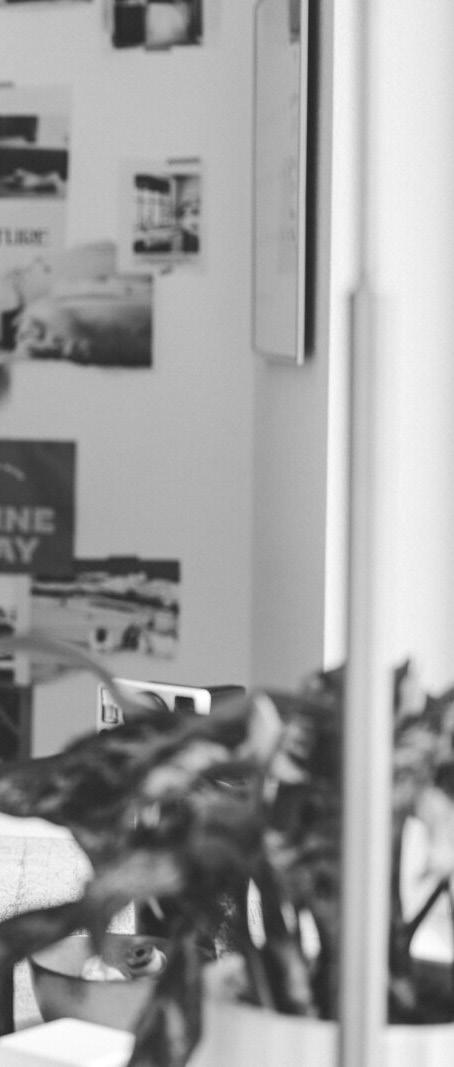
paved the way for the wedding industry at the time. We worked on her branding and creating her website; the rest was history. After everything was launched, our inbox was flooded with referrals and requests because of our connection with her brand.”
“I realized by working with [Michelle] that being around her beautiful work made my job easier and inspired me to create equally beautiful and important work. Her work only enhanced mine.”
Fast forward seven years, and Carrylove Designs has expanded into two different segments. “We have a branding side where we help with websites and brand work; then we have the marketing side.” This includes social media work, SEO, blogs, and email. Her and her team’s success speaks for itself: Reviews credit the CLD team with massive profit gains, exponential engagement and followers, and even team growth.
As proud as she is of those client wins, Amanda realized a few years ago that to level up
her own company with massive profit gains and exponential team growth, she needed help of her own.
“Being an employer was much more stressful than I imagined,” Amanda shares. “Suddenly, I was responsible not only for my family, but also for supporting other people’s families. That can weigh on you and limit your ability to be creative. So I knew I needed help.”
And that help came in the form of Venus Michael.
“I met Venus through a mutual friend; I was at a point where I knew I had goals I wanted to accomplish, but I needed to manage my cash flow better, to know how much to spend and where to spend it.”
Amanda goes on to explain that because of Venus, aspects of business have become more apparent. “We had a big hire earlier this year, and Venus hopped on a call with me to see what we could do and what we could offer to ensure everyone walked away happy. Having somebody in our corner with my best interest is invaluable.”
“From jumping on calls to helping me make confident decisions, and knowing down to the percentage point how much I should be paying my contractors and myself… Venus is always there, keeping an eye out for me.”
For many creatives, finances are a four letter word, and Amanda isn’t the exception. “I hate looking at the numbers, so Venus does a lot of that; the less I can deal with finances, the better.” Leaving the money to the money experts, and leaving the creatives to their works, culminates in a partnership that exudes trust, confidence, and friendship.
“From jumping on calls to helping me make confident decisions, and knowing down to the percentage point how much I should be paying my contractors and myself… Venus is always there, keeping an eye out for me.”
With business booming, and goals of growth on the horizon, Amanda has taken her creative energy and redirected it into more public-facing endeavors. From summits, conferences, and workshops, Amanda is a
sought-after presenter and trainer. And now, a speaker. “Recently, I was asked to speak in Los Angeles at an events academy, and it really hit me— the rush of adrenaline and the momentous impact I could make on another person’s business, as well as the impact it makes on my own.”
Though “keynote speaker” isn’t yet something she’s ready to add to her repertoire, Amanda is ready to explore more options in speaking and training. “It’s a way to make an immediate impact in someone’s life or business. And as a luxury white glove service, I gain immediate credibility and trust when I take the stage. It’s been a wonderful way to market and spread the word about my brand and my company.”
Who knows, maybe 13 Going on 30 gets a reboot with a TedX twist.


I’m working on implementing Profit First on my own and it’s not working the way I thought it would. What am I doing wrong?
First of all, it’s completely normal to encounter challenges when implementing a new financial strategy. So don’t panic! Here are four common steps you can take to ensure Profit First works optimally for you.
1. Review Your Allocation Percentages. One of the most common issues with Profit First not performing as expected is incorrect allocation percentages. It’s crucial to ensure that the percentages allocated to your accounts truly reflect your business’s operational needs and financial reality.
2. Analyze Cash Flow Regularly. This isn’t just about knowing what comes in and what goes out. It’s about understanding the timing of income and expenses and ensuring that you’re not running into cash crunches. Let’s work together to create cash flow forecasts and financial dashboards to get a clearer picture of your financial health!
3. Double-check the Numbers. Sometimes, the issue lies in not having enough visibility
into where exactly your money is going. Use detailed bookkeeping practices to track every dollar and cent. This can help you identify leakages or unnecessary expenses that might be undermining your Profit First implementation.
4. Adjust for Growth and Scale. As your business grows, your financial systems need to evolve. If you started Profit First early in your business journey, the process that worked in the beginning might not be adequate now. Consider whether changes in your business model or size require a new approach to your financial management. Finally, stay consistent with your efforts, and keep your long-term financial goals in focus. If you don’t start seeing better results, consider booking a consultation with us. As Profit First Professionals, we can provide personalized advice and guidance tailored to the nuances of your business.
I’m a solopreneur. Why can’t I just use one checking account for both business and personal expenses?
Mixing personal and business expenses is one of the most common bookkeeping
mistakes made by small business owners. And to be fair, it’s easy to do. Let’s say you stopped at an office supply store to grab printer ink for your office and picked up a new fiction book while you were there. Or, maybe you went grocery shopping but paid with your business credit card. Sounds innocent enough, but it’s a bookkeeping nightmare. Taking time to do things right, even if it’s inconvenient, will help you avoid many problems later on, such as:
• Audit risks: If you claim personal expenditures as business expenses, you might face serious risks during tax audits. Auditors can deny deductions, impose penalties, and even take legal action.
• Impaired creditworthiness: If you’re seeking a loan, lenders may question your financial responsibility if they find evidence of comingling. This could impact your ability to secure funding.
• If you comingle funds, you could lose your LLC’s or corporation’s liability protection due to what is known as “piercing the corporate veil.”
Starting healthy bookkeeping practices at the beginning of your business journey will only set you up for success as your business grows!

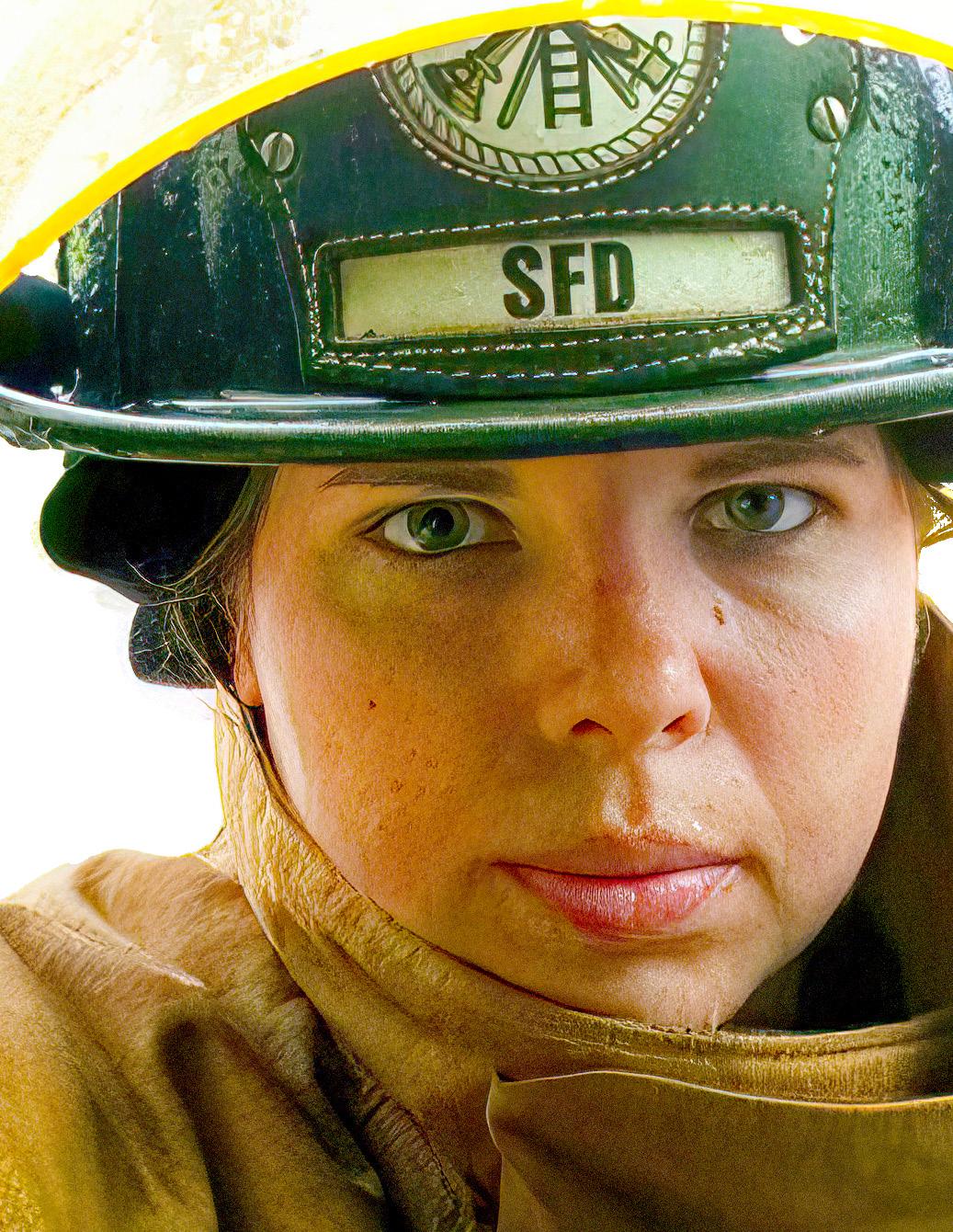

Jennifer Fink ingeniously merged her passion for photography with her unwavering commitment to service, birthing a flourishing portrait empire.
Firefighters are naturally drawn to light. Whether it is the glow of a structure fire as they race down the highway, the sterilizing brightness of an emergency room, or a parade of radiance as their sirens illuminate the way to an emergency, light is an inherent part of what they do.
It’s no wonder many firefighters turn their attraction for light into a passion for photography. At its most basic meaning, the word photograph translates into “to draw the light.” The shaping of these images tells a story about the world around us.
Adorning the walls of fire stations worldwide are landscapes of the service area or crew photos of those who have served before. These photos are a window into the department’s soul, and the department upholds the tradition of these “firehouse photos” with pride and ownership.
One such person, Jennifer Fink, a professional photographer and former volunteer firefighter in South Carolina, keeps this tradition alive as a profitable business.
“My family has a long line of service heroes. My dad and uncle were a firefighters, my aunt was a captain, my brother is a police officer, and my aunt and grandfather were both EMTs,” Jennifer says. “It’s not a surprise why I have such passion for documenting and working with these heroes.”
In third grade, Jennifer remembers going to a fire with her father. “He couldn’t exactly leave me at home, so I stayed in the pickup, watching the firefighters try to salvage the home. I remember that moment—I could even tell you exactly where the house was these years later. I knew at that moment what I wanted to do. I wanted to help people and became a volunteer firefighter at age 18.”
While attending college, Jennifer was on the volunteer firefighter team, taking botany classes and working at a photography store. “I quickly learned that math and science were not my thing, so I switched my major from botany to photography. With my desire to serve, I figured I could enlist in the military and become a combat photographer,” she recalls. Ultimately, she decided against the military, choosing instead to open a portrait studio.
One-tenth of a second. That’s the speed of a first impression; all the time it takes for someone to judge who they think you are. Right or wrong, fair or not, it is how you and your brand are judged; which is why nothing is more powerful than photography. For business clients, the way you represent yourself visually is often the first impression that prospective clients use to determine the value of your brand. The
right image can create a feeling of trust, tell a story, and strengthen your message.
The same is true for weddings and families. Squishy babies turn into toddlers, toddlers into teens, and your high school seniors go off to college.
Portraits make these all-toofleeting moments more tangible and memorable. They’re a visual legacy.
“Great photography tells a story,” Jennifer says. “That’s true no matter what type of photo you are creating. An heirloom baby portrait. The first kiss at a wedding. A prom-posal. A branding shoot for your business. It tells the story of who you are at that moment in time.”
With a classic yet distinctly modern style, Jennifer creates refreshing, compelling portraits that document the honesty of real life. “Every person is different, and I believe your portraits should reflect this. Whether you are sassy or laid-back, have a classic style or are whimsical and carefree, it’s important to capture that authentically.”
Since 2005, Jennifer has been documenting these timeless memories—hence the name of her business—in her studio and locations around the world.
“I’ve had the chance to travel and capture stunning photos for people from Hawaii to Santorini to Boston to Houston to Lake Tahoe and more. If you can envision it, I can create it,” she says.

“My family has a long line of heroes…service It’s not a surprise why I have such passion for documenting and working with these heroes.”
And while these are all treasured moments that Jennifer is honored to capture, she has since discovered a larger purpose in capturing our community’s heroes. This market is wildly under-saturated and lacks people willing to document these people and events.
“I started photographing my local fire department and picked up the police department. Within a year, I picked up a few more fire departments in the neighboring counties, and it just grew from there.”
Just like a fire, a spark set in motion a blaze of business for Jennifer: Her skill set and a unique understanding of the personal sacrifices these individuals make fuels her passion and dedication. So much so that since the fall of 2022, Timeless Heroes Photography has immortalized 87 departments. “It’s crazy that my passion filled such
a gap of need in the industry. The word-of-mouth aspect of our business has been imperative, and honestly, the passion for this project filled the gaps in the calendar of my traditional shoots.”
Today, her thriving photography business crosses various photographic genres. “Right now, I’m juggling 13 commercial jobs, six portrait jobs, and two weddings. I have contracts with nearby colleges where I do event photography. And I even do photo restoration, taking an old photo and bringing it back to life for families or even historians. All of that in addition to the heroes project… it’s a little insane,” she says with a laugh.
Indeed, her calendar has a busy book of businesses and people requesting her services far into next year. However, the heroes project has gone from a passion project to a lucrative revenue stream. “About
85% of my income right now comes from the service side of my business, and I really have Venus to thank for that.”
She’s speaking of bookkeeper and Profit First Professional Venus Michael of One21 Account-Ability.
“Venus has given me the tools necessary to create an entire new business entity,” Jennifer says. “It all started when I went to hear Mary Fisk-Taylor speak, and she presented about Profit First. I was inspired to learn more, so I read the book and was completely intrigued. It was a new and insightful way to look at my finances, but it was more challenging than I knew I could handle on my own.”
So she went looking for help online.
“In a Facebook group for photographers, Felicia Reed posted about her experience with Profit
“About 85% of my income right now comes from the service side of my business, and I really have Venus to thank for that.”
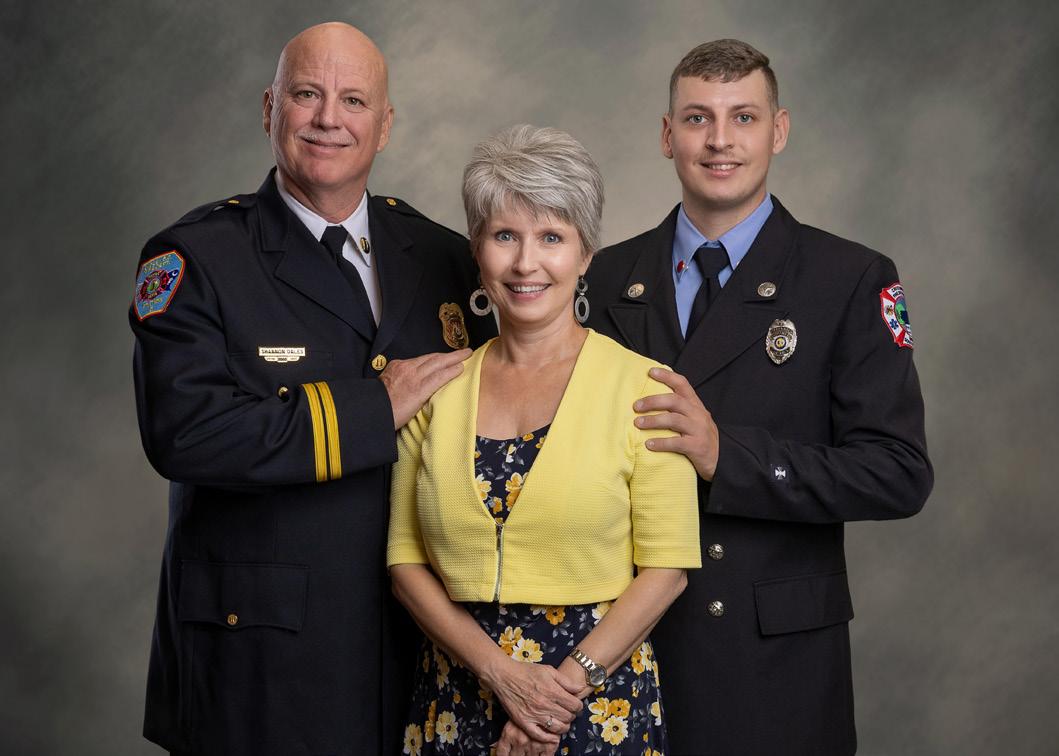



First and gave all the credit to her bookkeeper, a woman named Venus Michael. And I knew I needed to meet her.”
Like any business owner, Jennifer researched, looked at Venus’s website, read reviews, talked it over with her husband, and even had a consultation call. “My first thoughts were, ‘Oh my god, that’s a lot of money,’” she laughs. “But as I chatted more and more with my husband, he said, ‘If it’s going to take something off your plate, I say go for it.’
“I signed up with Venus in the fall of 2019, and she’s been nothing but amazing. She helped me navigate COVID and has become a lot more than just a bookkeeper to me—she’s a business mentor, a strategist, and a partner,” Jennifer shares.
When Jennifer first started with Venus, she was by all means a successful photographer.
“I’ve been incredibly fortunate with my business,” she explains. “Within the first three years, I was consistently hitting six figures, hovering just over $100,000 year after year. But no matter how hard I tried, I couldn’t break that ceiling. I was comfortable and happy. I was paying for my studio space, the utilities, and of course, there are always new props, accessories, and cameras to buy, but I never took on any debt, which was great. But I just couldn’t break $100K. That is, until Venus and Profit First.”
“Within a year of working with Venus, my business grew
nearly 40%. And another 40 or 50% the following year. The combination of smart bookkeeping and Profit First completely changed my life. I can pay myself now, give myself and my assistant, Angela, raises, and even take my family to Hawaii. It’s incredible what you can do with your money when it’s managed properly.”
Jennifer also credits Venus with the launch of Timeless Heroes.
“She was always asking me about my passion projects and encouraging me to follow them. At first I thought photographing firefighters was just a way to give back to a community that I loved, but Venus helped me see that I could do that and make money with it as well. For almost 19 years, I have owned Timeless Memories; but with Venus’s encouragement and guidance, I have been able to launch and grow Timeless Heroes.”
Her success hasn’t gone unnoticed. This year, Jennifer was invited to speak at the prestigious ImagingUSA conference, the premier photography conference put on by the Professional Photographers of America [PPA]. She shared the inspiring story of Timeless Heroes and Profit First with hundreds of fellow photographers and business leaders. And she has since been invited to speak at other local and regional conferences and events.
With dozens of department patches in her office from the countless heroes she has
photographed and a calendar full of repeat clients, Jennifer’s heart is full. Her cup runs over with grace and gratefulness.
Often, the most valuable aspects of life can be encapsulated in the assurance that you are making a positive impact.
Jennifer has dedicated herself to capturing meaningful moments through photography. Her work graces the walls of various departments, and families treasure her images of their loved ones. In the unfortunate event of a hero’s passing, Jennifer’s photographs are used as official portraits to preserve their memory for eternity. And she herself continues to give back, preparing to volunteer once again as a local firefighter herself. “I can’t escape it, it’s just in my blood,” she says with a smile.
Jennifer takes stunning photos, and her passion for capturing the heroic moments of life has inspired many. With the assistance of Venus and One21, she continues to blaze a trail, encouraging others to follow her path and reap the rewards that come with it.


“I can pay myself now, give myself and my assistant, Angela, raises, and even take my family to Hawaii. It’s incredible what you can do with your money when it’s managed properly.”



Everything you wanted to know about Profit First, but were too afraid to ask.
1. What is Profit First?
Profit First is a system created by Mike Michalowicz, author of multiple business books, including Profit First: Transform Your Business from a Cash-Eating Monster to a Money-Making Machine.
Ok. Besides that. What is Profit First really?
In business, we’re always told that we need to pay ourselves first, but no one teaches us how. Until now.
Profit First rethinks traditional accounting by prioritizing profit before paying any expenses. We take income, prioritize a percentage for profit, and take whatever’s left to pay expenses. If there’s not enough left, we have too many expenses and need to make cuts.
If Profit First were a mathematical formula, it would look like this:

Someone Told Me It’s Like a Diet Plan for Finances. How does that work?
There are four key principles that are similar to the idea of dieting such as using small plates: Smaller plates equal smaller portions. Smaller portions equal fewer calories. Fewer calories typically leads to weight loss. In Profit First, smaller plates are dedicated bank accounts.
• Start with the good stuff first. Satisfying hunger with vegetables rather than chips leads to a healthier balance, and lower overall consumption. In PF that means paying yourself first.
• Remove temptation. If cheat foods are inconvenient to get, you’ll eat less of them.
• Find your rhythm: Don’t wait until you’re hungry to eat, instead plan ahead to manage hunger, which avoids binging, and results in fewer calories consumed. The result — for Profit First and dieting — is a leaner, fitter, and more profitable business.
Yes. Because it changes your mindset and teaches you about your finances. Profit is the priority and not a “leftover” after covering expenses, meaning you’ll budget your expenses more carefully, a la Parkinson’s Law.
5. What is Parkinson’s Law?
Author and historian C. Northcote Parkinson theorized that demand for a resource increases to meet the supply of it. That is why when we are given two weeks to do a project it takes two weeks, and when we are given eight weeks to do the same project it takes eight weeks. That is why when given $1,000 to complete our work we get it done with $1,000 and when given $10,000 to complete the same work, it takes $10,000. Profit First makes Parkinson’s Law an asset. By taking profit first, the money available for expenses lessens, and we are forced to find ways to get the same things done for less money.

Think of Profit First like the cash envelope system. You cash your paycheck and then divide it into various envelopes labeled for different purposes: Groceries, Gas, Clothes, Utilities, Rent, etc. When the envelope is empty, the money has run out for that category. The only way to spend more is to pull from another envelope. Profit First does the same thing, except with bank accounts, by allocating income in specific percentages, to specific ‘plates’: Income, Profit, Tax, Owners pay and Operating Expenses. Money arrives in your Income account, and is then distributed to the other accounts.
Yes. But don’t panic. We can help you figure that out. The 5 primary Profit First accounts are:
• Total income account. All of your income is going to be deposited here. Chances are, you already have this as your business checking account.
• Profit account. This acts as a cash-cushion/rainy-day fund as well as a quarterly source of profit distributions for you.
Profit is the priority and not a “leftover” after covering expenses, meaning you’ll budget your expenses more carefully, a la Parkinson’s Law.

• Tax account. The government always gets their money, so you may as well allocate it.
• Owner’s pay account. This where your salary comes from. And yes, you should always be paying yourself a salary!
• Operating costs account (OpEx). This is where all your expenses will be paid from. What you see in this account is what you have to work with.
• Working with photographers and creatives, we always recommend two more accounts, Business Growth and Equipment
8. Makes sense. But how do I determine what percentage goes into which account?
It starts with an Instant Assessment, which you can do on your own, or you can work with a Profit First professional—like us! — who can help. Either way, this requires an analysis of the company’s P&L and balance sheet and a review of the owners’ personal tax returns. From this information, we can develop your specific allocation percentages. We can also use industry benchmarks to establish goals for what those percentages should be for a high-performing company, and create a map for achieving those goals over time.
9. My business is already profitable. Can Profit First still help me?
Of course. Who doesn’t want to be more profitable? By using
Profit First, your business will progress more quickly to meet your long-term goals.
10. Can I implement the Profit First system before my business is profitable, or even started?
Absolutely! Even better to get those good habits hard-wired from day one. In fact, the sooner you start with Profit First the faster you will master financial discipline and ensure that your business runs efficiently. Plus, by paying yourself first, you are more sustainable and therefore more motivated to keep growing.

11. Since the Profit, Owner’s Pay and Tax accounts are all for the benefit of me, the owner of the business, can’t they just be one account instead of three?
No. While the money allocated to these accounts do all benefit the owner(s), the use of the
money is distinct. The Owner’s Pay is for the owner’s salary or regular recurring distribution. The Profit account is used as a quarterly bonus and/or a rainy day fund. The Tax account is used to pay the owner’s taxes and corporate taxes. So while the money does all benefit the owner, the accounts need to be kept separate so that you can instantly tell what money is allocated to what purpose.
12. More bank accounts means more bookkeeping, and I hate bookkeeping. Is Profit First really worth the effort?
Yes. In fact, the additional bookkeeping time required to manage and reconcile multiple accounts for Profit First is negligible, and possibly even more efficient than one using just one account. With Profit First you simply need to reconcile the deposits and periodic transfers from the Income account. All expenses and payments come from the OpEx account. And all the other accounts are typically a single transfer in on the 10th and another on the 25th, and a single transfer out at those times. It is easy to manage and reconcile. Besides, if you’re really lost, we can help!
13. What’s this about the 10th and 25th?
Profit First calls this the 10/25 Rule, where you allocate money from the Income account to
the Profit, Tax, Owner’s Pay and OpEx accounts on the 10th and 25th of each month.
By doing the allocation process and paying bills twice a month (on the 10th and 25th) you are not only more consistent and efficient, but it helps give clarity to your cash flow trends and statements.
Good question! The short answer is no, but it is important to understand the difference between a checking account and a savings account. As a general rule, savings accounts yield interest, but are limited in the number of withdrawals.
A checking account typically offers an unlimited number of withdrawals and checks, but does not yield interest. (Note that a savings account can’t write checks, so Owner’s Pay, Tax, Profit and other accounts won’t be able to issue checks.)
Following the 10/25 rule, the Income account will accumulate all deposits until they are allocated on the 10th and 25th. Therefore incoming funds “sit” in the Income account for approximately 28 days a month, enough valuable time to generate interest. Understanding this, the Income account can be setup as a savings account (to accumulate interest) and all the other accounts can be checking accounts. This will allow the most flexibility
for withdrawals and writing checks, while accumulating the most interest. Win, win!
Total Income is the top line revenue of a business. It represents all cumulative sales.
Real Revenue is the Total Income minus the cost of materials and subcontractors.
A business should only adjust to Real Revenue for Profit First purpose if a significant portion of the operations requires materials and subcontractors (typically more than 20% of Total Income). The rule of thumb is if you are a service based business with full time and part time employees do the Profit First process based on Total Income. If you are a manufacturer, retailer, restaurant or a service provider that delivers the signifi cant portion of its services via subcontractors you need to do the Profit First Process based on Real Revenue.
16.
No. Gross Profit is the total revenue minus Cost of Goods Sold (COGs). COGs can include mate rials, subcontractors, employee labor, project costs (e.g. project related travel), and ancillary costs (e.g. shipping costs).
Real Revenue is a simpler calculation and less subjective. It is total revenue minus
By using Profit First, your business will progress more quickly to meet your long-term goals.


SEE FOR YOURSELF
Contact One21 today to discover how Profit First could work for your business.
materials and subcontractors. Period. You do not subtract any labor of full or part time employees or other costs.
17. Can You Give Me An Example of Real Revenue?
Sure! For example, a home builder may have $10M in annual revenue and to complete their projects require materials and subcontractors that cost $7M a year. That this means is that the company really has $3M of “real revenue” and manages another $7M of transactions. This business needs to operate like a $3M company and not a $10M company. The term Real Revenue is used to make it very clear that the entrepreneur really has a $3M business.
18. Why is the Tax Allocation 15%? It Seems Very High.
The Tax account is intended to pay both corporate and personal taxes. When the owner has periodic taxes due, quarterly or otherwise, the business “pays” for the owner’s taxes. And since the money is being allocated to taxes on the 10th and 25th the taxes should be reserved well in advance to offset any panic when taxes are due.
19. Shouldn’t I Run Up Expenses to Cut Taxes?
That is one of the most damaging myths of money management. Running up expenses to reduce taxes is the same as spending ten dollars to save
three, it is very damaging to the business. The goal is to run the business as profitably as possible, and work closely with a Profit First Professional to additionally reduce your tax liabilities as much as you can.
Pay It Off and Still Take a Profit?
Pay all the minimum fees out of your Operating Expenses. Then use any remaining money you have in the OpEx account to pay off your smallest debt as fast as you can. No matter what keep doing the profit allocation of Profit First every 10th and 25th. This sounds crazy since traditional GAAP accounting would have you pay debt first, but you MUST build the habit of always taking your profit first. Then when you do your quarterly profit distribution, take 95%-99% of that distribution money and use it to crush one of your debts. The remainder (1%-5%) is used for you to celebrate. This process has you constantly chipping away debt while remaining profitable.

If you know One 21 Account-Ability even a little, you know we are deeply committed to helping business owners better understand their
bookkeeping and financial big picture, so they can experience peace of mind around their company’s money. Want to learn more about Profit First and how it could work for your business, specifically? Contact us today.

• Before you pay expenses, pay yourself first.
• Run your business based on what you can afford to do today, not what you hope to be able to afford someday.
• When profit comes first, it is the focus, and it is never forgotten.
And how to create yours in just 5 simple steps, even if you’re starting from scratch.

Do you feel like you’re stuck on the hamster wheel of your photography business, trading time for money and never getting ahead? What if there was a way to break free, leverage your expertise, and create a thriving business with more freedom and fulfillment? The secret lies in creating your own signature online course.
When you create an online course, you’re showing the world that you’re not just a skilled photographer, but a leader and innovator in your field.
Creating an online course will help you:
• Build a powerful personal brand and become a go-to authority
• Attract dream clients who trust your expertise and want to work with you

• Diversify your income streams
• Generate revenue even when you’re not shooting
• Have more freedom, flexibility, and time for what matters most
Nidhi, a successful photographer, felt stuck trading time for money. But then she had an idea: package her expertise into an online course.
She didn’t have a huge email list or a massive social media following, but she did have something even more powerful: a deep understanding of her target audience and the
specific problem they needed help solving.
So she decided to create a free training that would give her audience a behind-the-scenes look at what was working in her own photography business. She knew that this kind of insider knowledge would be incredibly valuable to other photographers looking to grow their own businesses.
In her free training, Nidhi shared her secrets for creating profitable “mini sessions” - short, targeted photo shoots that could generate thousands of dollars in just a few hours. She walked her audience through her entire process, from marketing to pricing to delivering an exceptional client experience.
The response to Nidhi’s free training was overwhelming. Her audience loved getting a peek behind the curtain and seeing exactly how Nidhi was able to create such a successful photography business.
But Nidhi didn’t stop there. She used the momentum from her free training to pre-sell her full course, even before she had created all the content. By showing her audience the kind of value they could expect from the full program, Nidhi was able to generate excitement and anticipation for her course launch. And the results? In just six weeks, Nidhi was able to pre-sell over $125,000 worth of course enrollments—all with an email list of less than 500 people!


Nidhi’s story proves that you don’t need a massive audience to create a successful course— just a commitment to providing value, solving problems, and building relationships.
1. Identify a specific, high-value problem you can solve for your target audience. Niche down and focus on a challenge you have unique skills and experience to help them overcome.
2. Test your idea with a free training or lead magnet that gives your audience a taste of your expertise and starts building relationships with potential students.
3. Pre-sell your course to validate demand and generate momentum before creating content. This helps you gauge interest, generate revenue
upfront, and tailor your content to your students’ needs.
4. Create actionable, results-driven content that helps your students achieve tangible outcomes. Break your course into manageable modules and lessons, and provide plenty of examples and hands-on assignments.
5. Launch and promote your course with a multi-channel strategy that gets it in front of the right people with the right message. Use social media, affiliate partnerships, and paid advertising (if it makes sense for your business).
Creating your own signature course is just one piece of the puzzle when it comes to building a successful online brand as a photographer. But it’s an important one—because when you have a course to offer, you have a powerful asset that can help you attract clients, generate passive income, and create more freedom in your life.
If you’re feeling inspired to create your own signature course, Andrew and Stefi specialize in helping photographers package their expertise into profitable online courses. Visit CourseBuilderPros.com to learn more and tell them One21 sent you.
When you create an online course, you’re showing the world that you’re not just a skilled photographer, but a leader and innovator in your field.

 STORY MELISSA S. W. DARVEAU
STORY MELISSA S. W. DARVEAU
Every business embarks on a journey with distinct phases— beginnings, growth spurts, maturity, and transitions. Throughout these stages, navigating financial matters is paramount. Whether you’re a startup, scaling up, or transitioning ownership, understanding financial strategies will be one of the keys to your success… or failure.
Entrepreneurs often dive into their ventures fueled by passion and vision. Yet, grappling with financial statements like profit and loss (P&L) or balance sheets can be daunting, especially in the nascent stages. Startups often find themselves helmed by CEOs or ‘Chief Everything Officers’, juggling sales, strategy, marketing, bookkeeping, and operations. However, spreading oneself too thin can hinder future growth. Recognizing the need for expertise is vital.
Consider this a start-up cheat sheet if you will.
Getting Started: First and foremost, assemble a robust team of professionals who can offer guidance in areas where you lack expertise. View this as an investment in both yourself and your venture. Free or low-cost resources like the Small Business Administration (SBA), local chambers of commerce, and entrepreneur-focused nonprofits can be invaluable. Surround yourself with experienced marketers, CPAs,
bookkeepers, business coaches, and bankers—all essential allies in navigating the business landscape.
Next, ensure your business is legally sound. File your business name, obtain an Employer Identification Number (EIN), and establish an operating agreement, particularly if there are multiple owners. Depending on the complexity of your business structure, you may opt to enlist the services of a business attorney or tackle these tasks yourself with guidance from available resources.
Sorting out your business finances is paramount. Consult with your banker, who can offer valuable insights tailored to your specific needs. Consider a few key points: choose a business account suitable for your balance and transaction volume, facilitate convenient payment methods for your clients (such as ACH or merchant services), and start building business credit with a dedicated credit card.
Lastly, don’t shy away from using a business credit card. Aside from bolstering business credit and safeguarding your checking account from fraud, it also aids in overseeing employee spending. While some cards may require a personal guarantee, clarifying the implications with your bank is crucial. Remember, responsible financial management lays the groundwork for future success.
is a 23-year banking veteran. A native Austinite and graduate of Texas State University, Melissa is a Commercial Banker in the Austin area for Truist Bank. She has extensive finance experience and is wellversed in financial reporting. She has a strong understanding of the story a company’s financials are telling. She applies a consultative approach to coaching business owners on how best to 1. Begin, 2. Stabilize, 3. Grow or 4. Transition
In her free time, she enjoys gardening, traveling and taking motorcycle rides through the hill country. She currently lives in the Central Texas Hill Country with her husband, Dale, as well as their 5 dogs and 5 cats.
